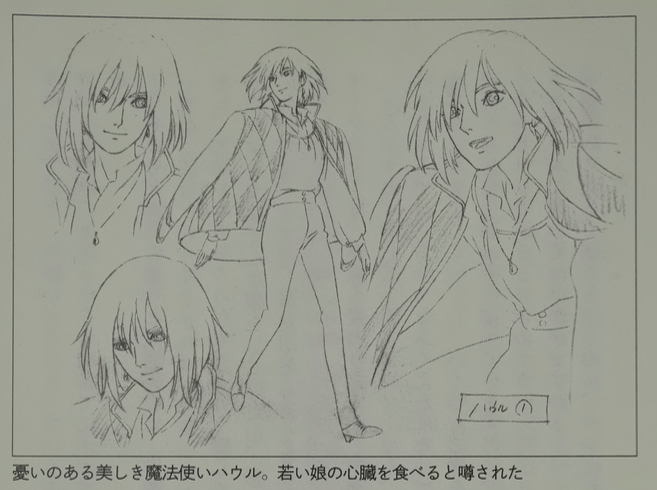Takeshi Inamura (Animation Director)
Prioritize simplicity over Western-ness
Interviewer: When Director Miyazaki first asked you to join as an animation director, what did you think?
I had already received a description of “Howl” from Mr. Toshio Suzuki and thought it was interesting. But I thought it would be physically impossible to direct a feature-length film by myself. From what Mr. Miyazaki said, “Yamashita (other animation director) says he’s going to direct,” I thought if that was the case I would take the role (as the second animation director). But when I asked Yamashita later, it seems like he said to Mr. Miyazaki, “I want you to do it because Inamura will do it.” (laughs)
Interviewer: How did the two of you proceed with the work in the early stages?
Director Miyazaki would do the original drawings, Yamashita would compile them, and I would finish them. But I couldn’t finish all of them in time, so Yamashita also did some cleanup to a certain extent. We realized, however, that it would be impossible even with two people, so we were looking forward to Mr. Kousaka joining us (as the 3rd animation director).
Interviewer: What is your impression of the film “Howl”?
Honestly, until Director Miyazaki’s storyboards were submitted, it was hard to grasp. It was my first time dealing with something set in Europe since “Porco Rosso”. When I started drawing Western people in a European city, I realized how little I knew (laughs). So at first, I was really confused. For example, I didn’t know how they walk. But I did wonder if there was really a need to draw them so Western-like.
Interviewer: So, you decided not to focus too much on Western-like gestures?
If we were going to do that, we, as animation directors, would have to create a format of Western customs and gestures and convey it to the staff. But we’re Japanese, so we don’t know how much that will be conveyed, and it takes time to understand. I don’t know if it’s true, but I read somewhere that in old Paris, if a woman swung her hand while in stride, everyone would be surprised. Maybe it wasn’t considered beautiful to walk swinging one’s arm when walking. We had to research and thoroughly discuss whether Sophie should go that far. The conclusion was that we just had to continue with our own style of drawing. Actually, Sophie does walk waving her hand in the film (laughs). We thought it might be better to take a style that makes it easier for us to intuitively convey the character’s mood to the audience. So, we drew all the characters simply. I paid attention, though, not to make the drawing style too simple.




Human Beings are Constantly Changing
Interviewer: What do you mean by a drawing style that’s too simple?
It means not simplifying a personality by labeling someone as a good person or a bad person. Even the Witch of the Waste probably doesn’t act thinking she’s a villain from the start (laughs).
Interviewer: Whether it’s Sophie, Howl, or the Witch of the Waste, the appearance constantly changes. Wasn’t it tough?
If I can understand the base personality, I don’t think it matters much how the appearance changes. Of course, I do struggle and worry about what kind of face to draw for each scene, but I wasn’t too concerned about age. The cuts, however, didn’t come up in the order of the movie’s progression, so that was really tough.
Interviewer: As an animation director, you usually work regardless of the story’s progression, right?
Well, it would be best if we could do it according to the progression of the film (laughs). When I was drawing young Sophie, suddenly a cut of an old lady would come, so the cuts were scattered, and it was rather difficult to remember what face she had in the previous cut. For example, in the air raid scene, Sophie gradually gets younger, and I had to be careful with scenes where I had to go through such stages.
Interviewer: Sophie not only changes her appearance but also grows considerably internally throughout the movie, doesn’t she?
That’s right. Even with the same young Sophie, she’s quite different at the beginning and the end. Compared to the beginning, she’s a bit plumper and cuter at the end. In reality, people are constantly changing and have many faces. This time, we’re not afraid to depict the characters’ changes, so I hope the result will be well received intuitively.
Interviewer: How about Howl?
Drawing beautifully in terms of form was indeed tough. At first, Yamashita said to me, “I’m not good at drawing beauty, so please take care of it”, but I also struggle with it also (laughs). Beautiful people often tend to have a weak presence, don’t they? Drawing Howl, including his humanity, so that he exists in that world as Howl, was quite a struggle. I’ve never seen a person like that in real life. There’s definitely none like that in Ghibli (laughs).
Takeshi Inamura: Born in 1969 in Gunma Prefecture. After working at Shin-Ei Animation, he joined Studio Ghibli productions starting from “Porco Rosso” (animation). Afterwards, he served as the animation director for this work and “Tales from Earthsea” after contributing to key animations in “Pom Poko,” “Princess Mononoke,” “My Neighbors the Yamadas,” and “Spirited Away.” He has since played crucial roles such as key animation in “The Wind Rises” and assistant animation director in “When Marnie Was There.”